Intel Core i3-8350K Review
Why you can trust Tom's Hardware
Final Analysis
Dramatic changes to the Core line-up are a boon to PC enthusiasts, and there is little to complain about in the performance department. Intel's Core i3-8350K gives us twice as many cores at a supposedly comparable price point versus the previous generation. But considering we didn't like that last model much, the -8350K would need to be exceptional to earn our affection.
In the chart below, we plotted gaming performance with both average frame rates and a geometric mean of the 99th percentile frame times (a good indicator of smoothness), which we then converted into an FPS measurement. We're also presenting price-to-performance charts that get split up to include CPUs-only and extra platform costs. For the models that don't come with a bundled cooler, we add an extra $25 for a basic heat sink. We also add $20 if overclocking requires a more expensive motherboard (as is the case for Z370).
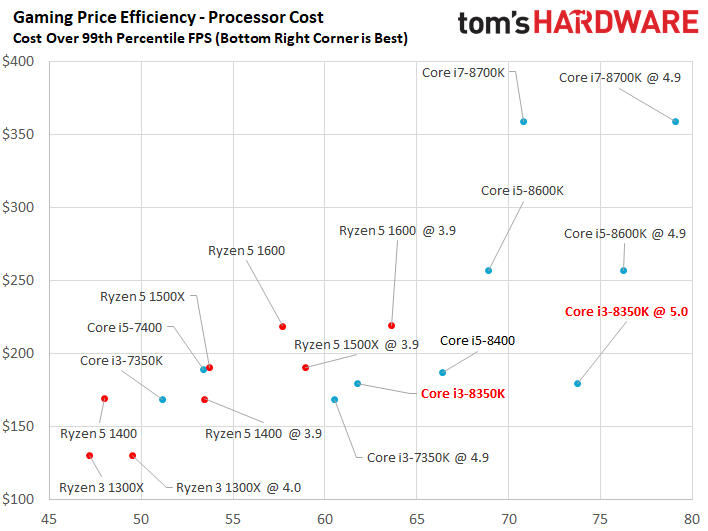
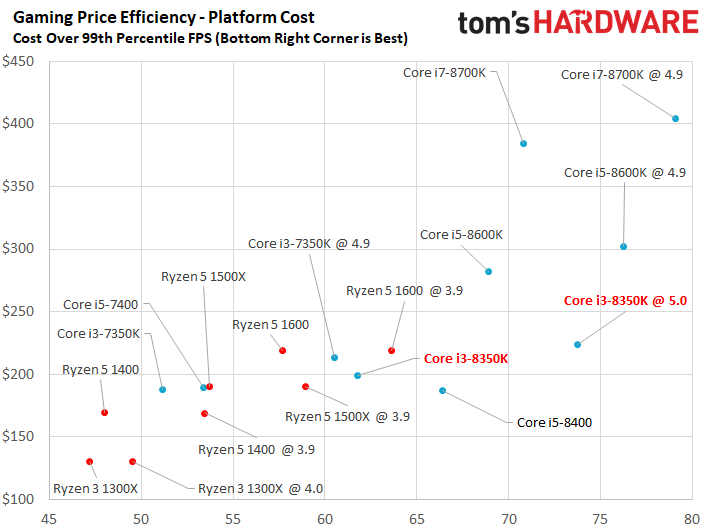
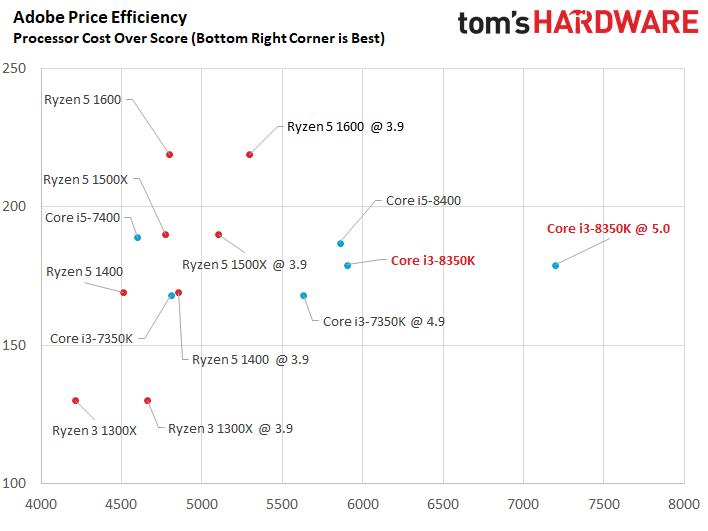
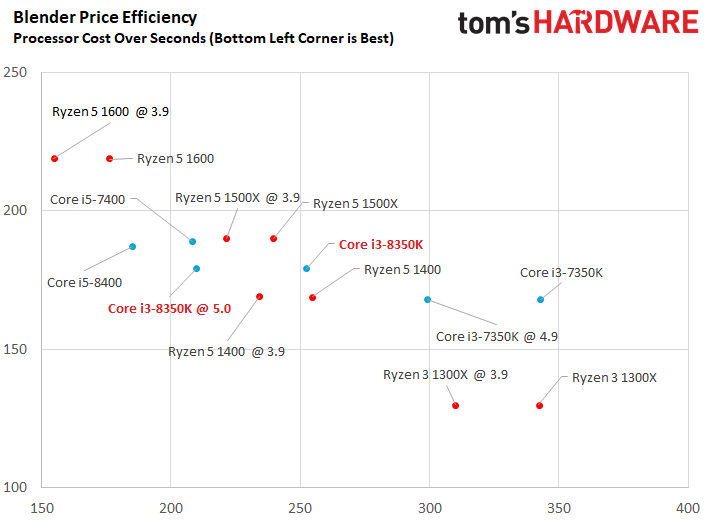
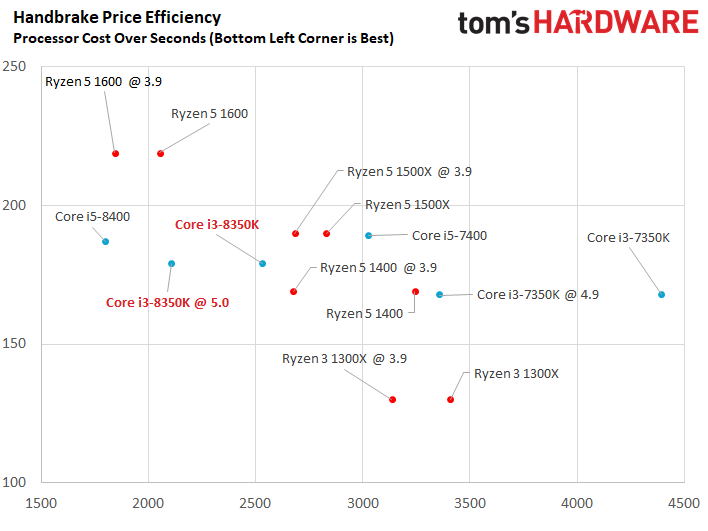
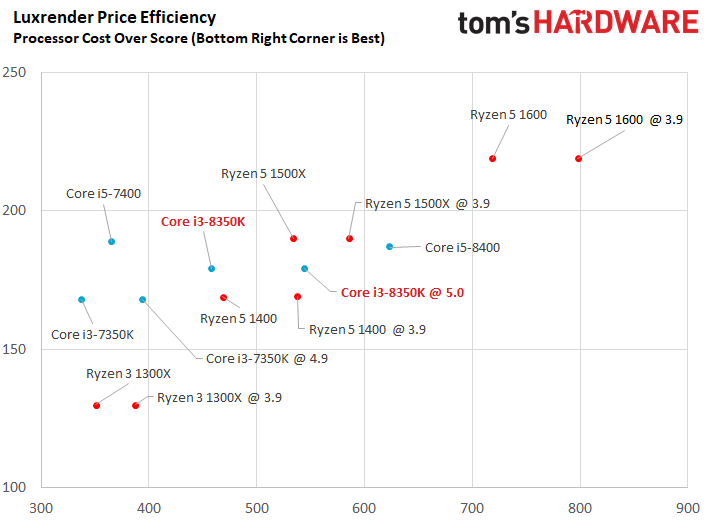
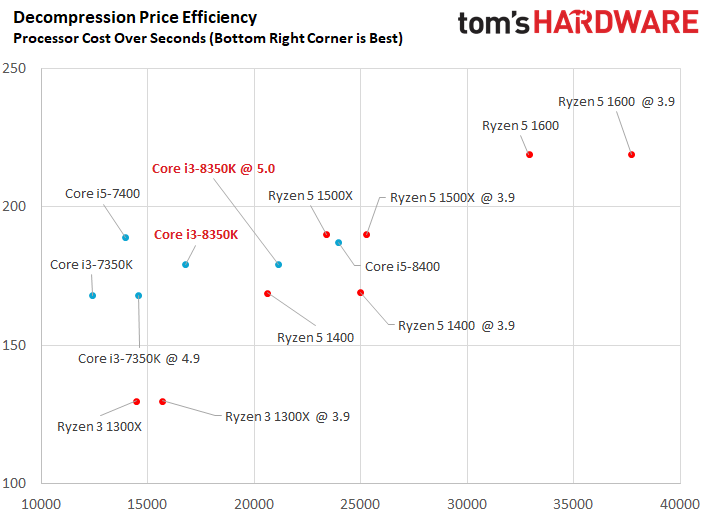
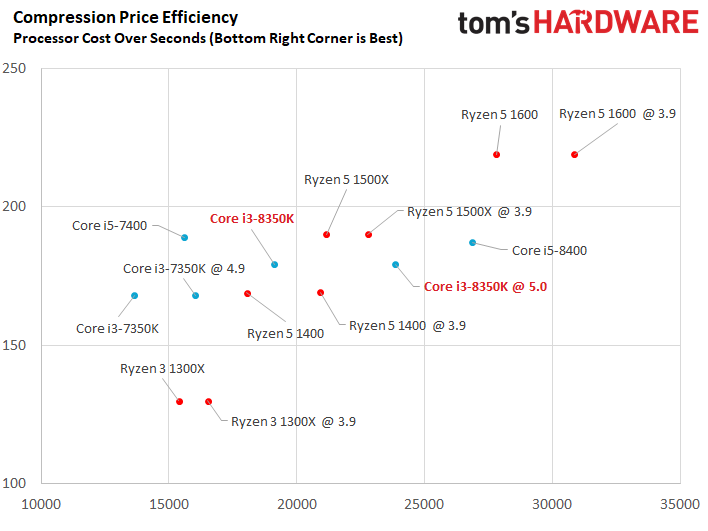
It's hard to beat an overclocked Core i3-8350K for gaming unless you have the cash for a pricier Core i5 or i7. In fact, the i3-8350K is surprisingly competitive with those more expensive Coffee Lake-based models if you spend some time overclocking. And Core i3-8350K destroys Kaby Lake in everything. An overclocked Ryzen 5 1600 provides the biggest challenge from AMD, but it's only able to go up against the stock -8350K. Overclocking propels this chip into a league of its own. The less expensive Ryzen 5 1500X also makes a compelling case for enthusiasts willing to turn the overclocking dials, but its much lower stock performance isn't as attractive.
The Core i3-8350K is surprisingly agile in our application suite. We recorded impressive performance in lightly-threaded applications, and observed competitive results in the multi-threaded workloads, too. Of course, any threaded benchmark is going to go Ryzen 5 1600's way. But Intel's quad-core Core i3 does help close distance that Kaby Lake lost to Ryzen, so the losses in heavily-threaded workloads aren't as pronounced.
And that's the issue we have right now with Ryzen 5 1600. You gain some performance in productivity workloads, as expected from a 6C/12T processor, but you lose quite a bit of single-threaded speed in other applications. Core i3-8350K presents a more balanced profile.
Speaking of balanced, the Core i5-8400 is our biggest winner here. You can drop it into a cheaper B-series platform, once those arrive, and get a really good mix of performance across the board. It also comes with a bundled cooler. You won't get the extreme gaming performance available from an overclocked Core i3-8350K, but you're going to gain a lot of flexibility in other workloads. Software is undoubtedly evolving to utilize multi-core architectures more extensively, so the two extra cores should come in handy down the road.
We weren't particularly fond of Intel's Core i3-7350K. Its high-end motherboard requirement and lack of a bundled cooler were out of touch for this value-sensitive segment. Core i3-8350K suffers from the same problems, compounded by limited availability leading to insane premiums. Even at Intel's MSRP, you're only a few bucks away from the six-core -8400 that comes with a thermal solution and drops into a cheaper motherboard.
Get Tom's Hardware's best news and in-depth reviews, straight to your inbox.
Given what we've seen from Coffee Lake, it's time to steer you clear of Kaby Lake. But Intel won't let us. The lack of any meaningful Coffee Lake availability is causing severe price gouging, making it difficult for us to recommend anything from Intel's line-up right now. Should the Coffee Lake models fall to where they're supposed to be, they'll represent a big step forward in computing power for your dollar.
MORE: Best CPUs
MORE: Intel & AMD Processor Hierarchy
MORE: All CPUs Content

Paul Alcorn is the Editor-in-Chief for Tom's Hardware US. He also writes news and reviews on CPUs, storage, and enterprise hardware.
-
Brian_R170 Newegg shows the Core i3-8350K in-stock right now for $189 (still $10 higher than "recommended customer price" from Intel), but well below the pricing button that says it costs $250 on Newegg. I thought those pricing buttons were updated real-time now?Reply -
salgado18 Intel made a mess of a rushed launch to answer Ryzen, but there is one thing they are unbeatable: low price. I know, they have always been expensive, but given the circunstances, it's very easy for them to underprice their chips to have better value.Reply
Well, sounds bad, but then again AMD triggered this, and consumers are the winners, right? -
Quaddro How to block permanently the ad video..?Reply
Dude, i'm in limited quota here..
I dont want to waste every bit for some useless video.. -
mhokett So my I7-4790K is now being beat in cinebench by an OC i3. At stock speeds it gets a Cinebench score of 830 and the OC i3 gets 840. So glad i can still OC it and at least beat the i3.Reply -
1_rick "It's only a shame that, as with all K-series processors, you're on the hook for your own thermal solution."Reply
Translation: "We're disappointed that Intel didn't bundle in the usual under-powered fan that you'll need to replace if you want to overclock." -
rgrigio Should i assume it to be as fast as a STOCK i7 4790k? At least when only 4 cores are required?Reply -
East17 I believe we need to stop putting so much emphasis on <current> single threaded performance. As long as the difference is not over 20%, for gamers and power users this matters less now.Reply
All games, all apps and even browsers are going Multi-Threaded so what's the point in putting so much emphasis on Single Threaded performance ?!?
Sure, if AMD or Intel launch a new gen of CPUs that double or triple the single threaded performance, that's worth the talk, but differences between 0% and 15% are not worth to fill entire pages of a review with.
Anyway, I'm not an expert reviewer :) It's just my opinion after 20+ years in IT hardware industry.
I generally want a very capable processor at a good platform price with modest IDLE power consumption. The rest is arguable. If it can game, good. If it can game well, even better, but I'm never going to chose a less productive CPU just because I get 10% higher FPS. That's just me :)
The graphics can be a bit misleading .... I would really like to see them full scale.
Because the way they are now, you get the impression that (in Gaming Price Efficiency - Platform Cost) AMD Ryzen 1300 is 10 times less capable than the i8400 which is not.
When you look at the dot placement on the table, you'll see that i5 8400 appears to be 1000% the performance of AMD Ryzen 1300 while only being 2 times the price. -
10tacle I've been waiting for this review. I'm looking to replace my dying i5 2500K backup gaming rig using a 1080p monitor that was built in Jan. 2011. It's severely showing its age. The price of the 8350k is a little higher than I expected, but since that rig is only for gaming and nothing else, the overclocking capability of it is impressive for improved FPS performance. And as the game benchmarks show, we are still not seeing most AAA title games really taking advantage of more than four cores over an overclocked four core CPU.Reply
If I was wanting to build a combination of both a gamer and multi-threaded video rendering box I'd still probably go with the Ryzen 1600 or 8400, but for a strict gaming box and going for a killer overclock, this wins hands down in the price segment. RIP to my faithful and trusty Sandy Bridge. You served me well for seven years - a chip that I successfully overclocked to 5.0GHz as well but never kept it that high due to the at-the-time rather weak Zalman 9700LED cooler...weak by today's higher end cooler standards. And thank you AMD for putting the pressure on Intel to add more cores to their i3 and i5 chips. -
why_wolf Reply20384951 said:Newegg shows the Core i3-8350K in-stock right now for $189 (still $10 higher than "recommended customer price" from Intel), but well below the pricing button that says it costs $250 on Newegg. I thought those pricing buttons were updated real-time now?
shows $189 for me. I doubt the button is updating it's pricing in real real-time. Probably more like once an hour. -
Llorelie Reply20385554 said:"It's only a shame that, as with all K-series processors, you're on the hook for your own thermal solution."
Translation: "We're disappointed that Intel didn't bundle in the usual under-powered fan that you'll need to replace if you want to overclock."
I know, this has bothered me in every review on this site that I have seen. I understand that its important that you inform consumers that you will need to purchase a heatsink, but if you are buying a -k chip and a z- motherboard, it seems likely that you'll want an aftermarket cooler. I would MUCH rather intel prices these chips $10 lower and not include a paperweight.